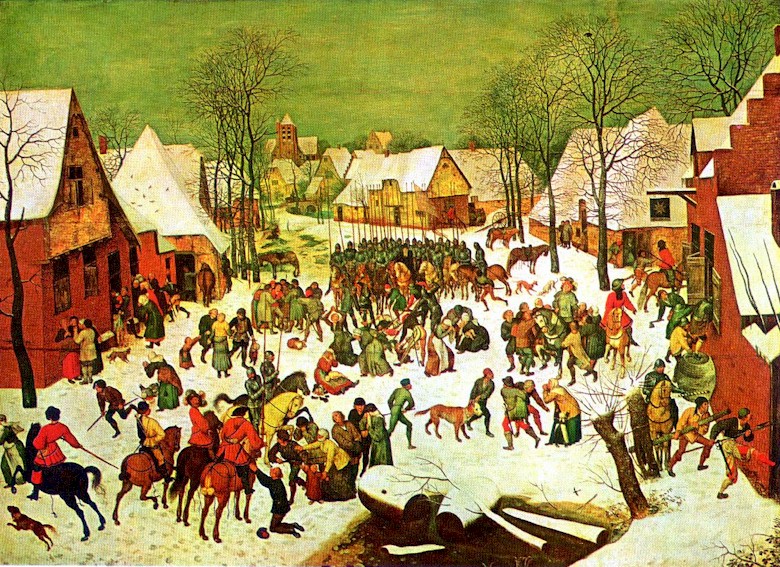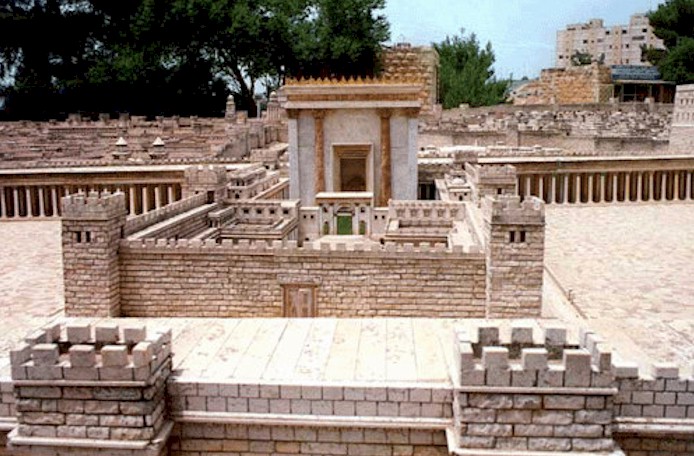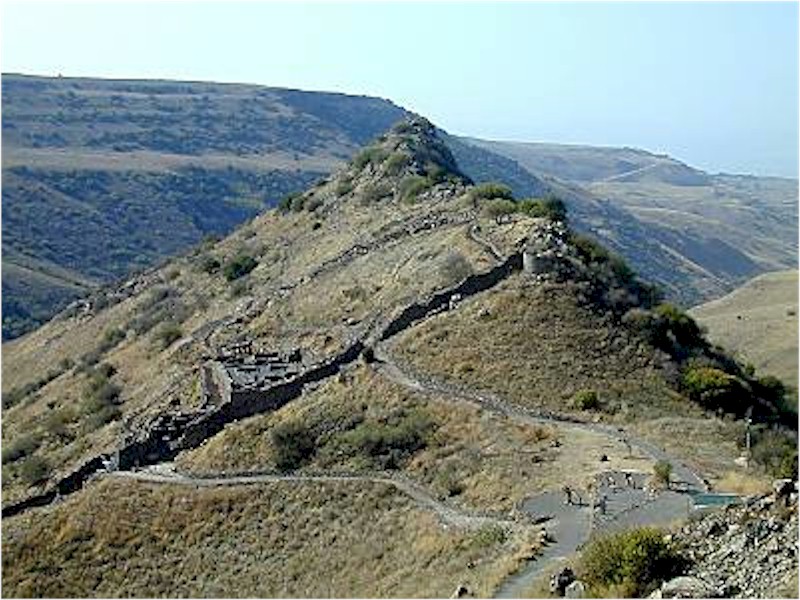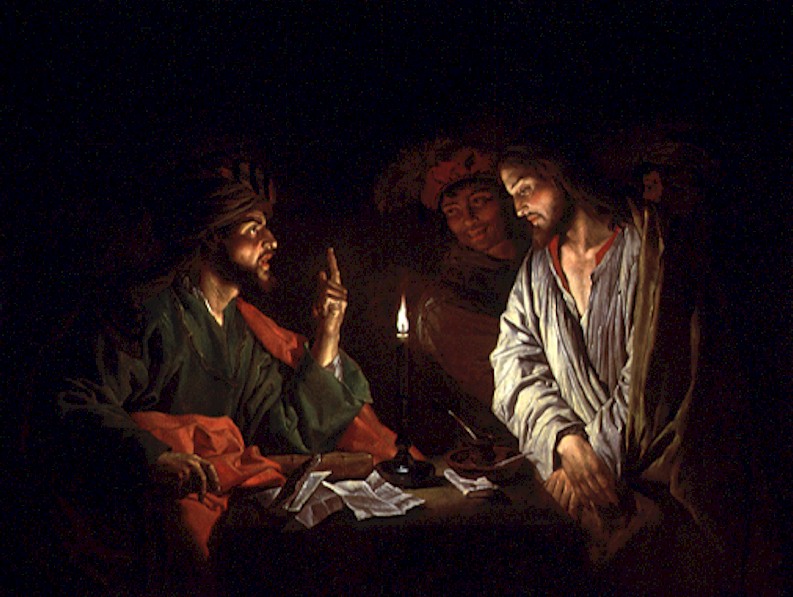Pontius Pilate
The Chapter's Title
In 1998, the Seattle based rock band Pearl Jam released the song Pilate, inspired by this chapter.
Judea
Judea is the southern part of Palestina, occupied by Rome in 65 BC. It was named after Judah, Jacob's fourth son. In the year 6 it became a Roman province. The residence of the prefect - called «procurator» by Bulgakov - was in Caesarea on the Mediterranean.
Pontius Pilate
Pontius Pilate (?-38) was the fifth Roman prefect of Judea from 26 to 36. Mikhail Bulgakov drew details for his portrayal of the procurator from David Strauss (1808-1874), already mentioned in the first chapter, but also from Life of Christ by the Dean of the Canterbury Cathedral, Frederic Farrar (1851-1905), from Vie de Jésus by the French historian Ernest Renan (1823-1892), Le Procurateur de Judée by Jacques Anatole François Thibault (1844-1924), who wrote under the pseudonym Anatole France, and the Gospel of Nicodemus, which probably was written in the fourth century, and of which the first part was entitles Acta Pilati, or the Acts of Pilate. You can download all these works for free in the archives of this website.

Ecce Home by Antonio Ciseri
In the Characters section of this website, you can read much more on Pontius Pilate by clicking the arrow below. There you can also read why we call Pilate a «prefect» and not a «procurator».
Herod the Great
Herod the Great (?75 BC-04), was the client king in Judea whom the Romans rewarded for his services by making him king. According to the New Testament, he ordered the murder of Jewish children - the Massacre of the Innocents - when he heard of the birth of the Messiah - the future «King of the Jews». A better translation might be: «King of the Judeans», as it was more for his influence on the kingdom of Judea than on his religious opinions that was executed.

The Massacre of the Innocents by Pieter Brueghel
Herod loved buildings in Roman style. It can be seen in the many palaces and other constructions he built in Jerusalem and in the city of Caesarea at the Mediterrean shore. According to the master's Pilate story, Caesarea was Pilate's preferred residence.
The Twelfth Lightning legion
The twelfth legion, Legio XII, was a Roman legion, levied by Julius Caesar (100 BC-44 BC) in 58 BC, which accompanied him during the Gallic wars until 49 BC. The legion's logo was the image of a lightning which gave it the name Fulminata - lightning is fulmen in Latin. The twelfth legion was also known as Paterna, Victrix, Antiqua, Certa Constans, and Galliena. Bulgakov found the name from the book L’Antéchrist (The Antichrist) another work by Ernest Renan (1823-1892), and made the annotation «12-й Fulminata» [12th Fulminata] in his notebook.
Yershalaim
Bulgakov uses an alternative transliteration of the Hebrew ירושלים [Yeru-shalayim] for the name of the city of Jerusalem. In certain other cases as well, Bulgakov has preferred the distancing effect of these alternatives: Yeshua for Jesus, Ha-Nozri for Nazareth, Kaifa for Caiaphas, Kiriath for Iscariot.
O gods, gods...
The refrain «O gods, gods...» runs through The Master and Margarita like a leitmotiv. It appears ten times in the novel and is taken from the opera Aïda written by Giuseppe Verdi (1813-1901), which Bulgakov knew and loved and quoted in other works.
Listen to the leitmotiv from Aïda.
Galilee
Galilee is the northern part of Palestine, green and fertile, with its capital at Tiberias on the Sea of Galilee, also known as Lake Kinnereth or Lake of Gennesaret.
The tetrarch
In Pilate's time, Galilee was ruled by the tetrarch Herod Antipas (20 BC-30), son of Herod the Great (73 BC-4BC). In a tetrarchy, the power is divided between four individuals. In the first century, the Romans also used the title of tetrarch to indicate the ruler of a smaller part of their vast empire.
Herod Antipas was responsible for the decapitation of John the Baptist (7BC-29).

John the Baptist by Titian
According to the Gospel of Luke (23:7-12), Herod Antipas was in Jerusalem at the time of Christ's crucifixion. Pontius Pilate had sent Jesus to Herod to pronounce judgment. It was meant to flatter him because they were at odds with each other. Herod was honoured but sent Jesus back to Pilate. The latter made judgment and washed his hands saying he was innocent of the blood of this just person. Since then Herod and Pilate were friends again. Luke 23:12 - «And Herod and Pilate became friends with each other that very day, for before this they had been at enmity with each other».
Sanhedrin
The Sanhedrin was the highest Jewish legislative and judicial body, headed by the high priest of the temple in Jerusalem. The lower courts of justice were called lesser sanhedrins. The Sanhedrin followed the Jewish law under supervision of the Romans.
A man of about twenty-seven
According to the New Testament, Jesus Christ was about thirty-three years old when he died. This is one of the many details in which Bulgakov deviates from the traditional biblical story. In his annotations for the third version of The Master and Margarita he wrote: «33-й год нашей эры. Иешуа мог родиться и в 4-10 году нашей эры (23 года?)» or «The year 33 of our era. Yeshua could have been born between the years 4 and 10 of our era (23 years?)».
Dressed in an old and torn light-blue chiton
The chiton is an ancient Greek garment consisting of straight pieces of cloth which had different sizes. These pieces of cloth were draped around the body, no scissors nor needles were used. Men wore a short chiton without sleeves, women a long one with sleeves.
Blue was a favourite colour among the Jews and was considered sacred. Bulgakov got this description from Life of Christ by Frederic Farrar (1851-1905): «...at each corner of His dress the fringe and blue riband which the Law enjoins (...) He is in the ordinary dress of His time and country».
Aramaic
Aramaic is a West-Semitic language which is spoken today as a first language in some villages around Damascus in Syria and in other parts of the Middle-East.
Originally it was spoken by the Aramaeans, but eventually it became the lingua franca of the entire Persian empire. So it became widely spread all over the Middle East, and consequently Palestina. Some passages of the Bible are written in Aramaic and not in Hebrew, and it is very likely that Jesus spoke Aramaic in his daily contacts with people. In the movie picture The Passion of the Christ (2004), directed by Mel Gibson (°1956), most of the dialogues are in Aramaic.
Ernest Renan (1823-92) wrote that «l'idiome propre de Jésus était le dialecte syriaque mêlé d'hébreu qu'on parlait alors en Palestine» or «Jesus' mother tongue was the Syriac dialect mixed with Hebrew, which was then spoken in Palestine». The Syriac was a dialect of Aramaic.
Today the language is considered to be endangered. After thousands of years it risks to disappear under the pressure of dominant languages and cultures in those areas where still exist Aramaic groups.
The temple of Yershalaim
The temple of Jerusalem was originally built by King Solomon (1000 BC-928 BC) in the 10th century BC. He was destroyed the first time by the Babylonian invaders in 586 BC and reconstructed in the 5th century BC. Herod the Great renewed it completely, but was destroyed completely by Titus in 70.

The temple of Jerusalem
Ratslayer
Boulgakov l'appelle Марк Крысобой [Marc Krisovoï]. Крыса [krisa] signifie rat et бой [boï] signifie lutteur. Dans les traductions anglaises il est appelé Muribellum (Glenny, 1967) ou Ratslayer (Pevear et Volokhonsky, 1997). Muribellum signifie Lutteur de souris. C'était un surnom romain pour les soldats peureux et pusillanimes. Muribellum est mis avec une intention ironique, bien sûr, parce que Marcus Mort-aux-rats n'était pas pusillanime du tout.
At the foot of a bronze statue
Statues in the decoration of palaces was a characteristic of the Hellenistic culture, and thus familiar to the Roman Pilate, but for Jews it was very unusual. But Frederic Farrar (1851-1905) wrote about the presence of sculptural porticos in the palace of Herod.
Hegemon
Ηγεμών or hegemon is Greek for leader, ruler or guide.
Yeshua
The name ישוע [Yeshua] is Aramaic and means the Lord is salvation. The name הנצרי [Ha-Nozri] means from Nazareth, the city in Galilea where Jesus lived before he started his public life.
Gamala
When Pilate asks him where he comes from, Yeshua does not answer Nazareth, the hometown of the biblical Jesus, nor Betlehem, his birth place. No, he says Gamala, and «indicates with his head that there, somewhere far off to his right, in the north, is the town of Gamala».
Gamala is a town northeast of Tiberias at the Sea of Galilee, which is traditionally not linked to the life of Jesus. None of the four canonical evangelist mention it, so why would Bulgakov do it?
Some historians argue that the absence of textual references to Nazareth in the Old Testament and the Talmud, as well as the works of Flavius Josephus (57-100), suggest that a town called Nazareth did not exist in Jesus' days. They think that Jesus lived in Gamala.
In 1927, the French writer Henry Barbusse (1873-1935) had supported this idea in his book Jésus (Jesus). He had written it because he had felt, as he said it himself, «a strong charm for the human and touching image of the jewish prophet, son of a worker carpenter, who encircled himself with people of modest condition and focussed himself on the humble». Barbusse did not believe in the divinity of Jesus, he believed in his love for mankind. He sympathized with a long time enduring tradition within the working movement: the idea of the revolutionary Jesus, killed by the mighties of the epoch of which he questionned their power. When he published an article called Jesus marxist in the journal L’Humanité to explain himself, many people were scandalized. Later on, Barbusse would write a theatre play called Jésus contre Dieu (Jesus against God) which would never be staged.
Gamala was the homebase of Judas of Galilee who had led a violent resistance against Rome in the year 6 and whose followers, the Zealots, formed a radical anti-Roman group refusing to pay Roman taxes. Jesus recruited his first apostles in the neighbourhood of Gamala. It can not be excluded that among his first followers there were quite some Zealots, even among the apostles. Jacob and John (sons of Zebedee) had sons of the thunder as nicknames, which could refer to the Zealots. It is even possible that Peter was a Zealot. His nickname Bar-jonah (Matthew 16,17) would refer to the Zealots. It means son of Jonah but also outlaw. In Luke 6:15 Simon the Zealot is mentioned among Jesus' closest followers, and maybe Peter's brother Andrew was a Zealot.

The ruins of Gamala
Close to Gamala, in Bethsaida, took place one of the two feedings of the multitude, which Jesus Christ would have done. It was the feeding of the 5.000, starting from five barley loaves and two small fish. It was shortly after Jesus had heard that John the Baptist had been killed. The crowd was enthusiastic, as was written in John 6:15: «So Jesus, perceiving that they were intending to come and take Him by force to make Him king, withdrew again to the mountain by Himself alone». After the miracle Jesus sent his apostles away. Matthew 14:22: «Immediately Jesus made the disciples get into the boat and go on ahead of him to the other side, while he dismissed the crowd». Some scholars assume that Jesus sent his apostles away to avoid them to be considered as Zealots by the authorities. This first feeding of the multitude at Bethsaida was described by all four canonical evangelists. A second similar miracle, starting from seven loaves and a few fish, from which a group of 4,000 people were fed, was described only by Mark and Matthew.
In three of the earlier versions of The Master and Margarita, Yeshua said that he was not from Gamala, but from Эн-Назира [En-Nazira], «pointing his hand in the distance». En-Nazira is the Russian transliteration of النَّاصِرَة [an-Nāṣira], the Arabic name for Nazareth. Viktor Ivanovich Losev (°1939), the compiler of My poor poor master, a book in which all saved versions of The Master and Margarita are brought together chronologically, suggests that Bulgakov may have found the name En-Nazira in Life of Christ (1874), a book by Frederic Farrar (1851-1905). But neither Farrar, nor the biblical expert Alexander Pavlovich Lopuchin (1852-1904), who translated Life of Christ into Russian in 1887, mentioned the name En-Nazira in their works.
Bulgakov may have found the name En-Nazira in a work he often used as a source of inspiration while writing The Master and Margarita, namely the Энциклопедический словарь Брокгауза и Ефрона [Entsiklopedesky slovar Brokhauza i Efrona] or the Brockhaus and Efron Encyclopedic Dictionary, a work of 86 volumes, which can be considered as the Russian equivalent for the Encyclopaedia Brittanica. Under the keyword Назарет [Nazaret] it mentions the Arabic name En-Nazira.
In the second-to-last version of the novel, Yeshua said that he was from Эн-Сарид [En-Sarid], and «indicates with his head that there, somewhere far off to his right, in the north, is the town of En-Sarid». That would also indicate Nazareth, according to many Russian philologists, although I have not found any sources confirming it. In the final version of The Master and Margarita En-Sarid became Gamala, but Bulgakov may not have found the time to look at it thoroughly, because in chapter 26 of the final version Yeshua is still described as нищий из Эн-Сарида [nishchni iz En-Sarida] or the beggar from En-Sarid.
A Syrian
Yeshua says: «I don't remember my parents. I was told that my father was a Syrian». Once again, Bulgakov differs significantly from the canonical evangelists who wrote that Jesus' mother, Mary, was still alive when he was executed, so he knew her well when he appeared before Pilate. Maria would have conceived Jesus immaculately, without having had intercourse with her fiance Joseph of Nazareth. Matthew and Luke wrote that Joseph was a descendant of King David (1040BC-970BC) who, according to the Hebrew bible, was the second king of the United Kingdom of Israel. Joseph was a carpenter by profession. He was last time mentioned in the Bible when Jesus was 12 years old. During Jesus' public life, he is not mentioned, leading many to assume that he was already deceased.
According to the Bible, Jesus also had brothers and sisters. His four brothers are mentioned by their names as James, Joseph, Simon and Judas, but his sisters are not named. Only in the apocryphal gospel of Philip is written about «his sister who was called Mary, just like his mother and his companion [Mary Magdalene]». Some Christians who believe in the perpetual virginity of Mary, say that Jesus had no real brothers and sisters, but that they were children born from a previous marriage of Joseph.
Matthew Levi
Many christians believe that the evangelist Matthew is the same person as the apostle Matthew, originally named Levi. It is very doubtful that this is possible, because it would mean that Matthew would have been very old when he wrote his gospel. Most Bible experts estimate the origin of the gospels as follows: Mark circa 65; Luke circa 80-85; Matthew circa 85-90; John circa 90-100. Others date the first three gospels somewhat earlier: Mark shortly after 60; Luke between 60 and 70 and Matthew shortly after 70.
In The Master and Margarita, Jesus and Matthew Levi know each other, but not long enough to speak of an apostle. Bulgakov refers clearly to the evangelist - «one with a goatskin parchment who follows me, follows me and keeps writing all the time».
Bulgakov never mentions the apostles in the novel. Although he makes Aphranius say that, «though we have been unable - so far at least - to discover any admirers or followers of his, it is none the less impossible to guarantee that there are none». But further they have no role, they aren't even mentioned. Just Matthew Levi is called once or twice a «disciple», though it's only by himself. Bulgakov's Matthew Levi has characteristics from both the apostle as the evangelist. He's a tax collector, like the apostle Matthew Levi, and wrote down the acts of Jesus, like the evangelist Matthew.
The apostle Matthew's calling by Jesus was rather controversial. After a conflict with the scribes Jesus left the city and went to the Lake Tiberias also called the Sea of Galilee. Along Capernaum, a town near the lake, was a seaway, the main road from Syria to Egypt. All goods entering Herodes' territory, were taxed at the Capernaum tollbooth, it was one of the four taxes that had to be paid. The tax collectors collected the tolls for the occupying force and often demanded more money than required to keep the rest for themselves. People hated them and they were so despised that their money was not accepted by the Jewish as alms and that their testimony was not legitimated in Jewish courts, because they were ritually unclean by their contacts with heathens. Matthew, called Levi by Mark and Luke, was such tax collector and the fact that Jesus called this man, must have been questionable for many Jews. When Jesus calls him, Matthew leaves his job and his old life behind him and follows Jesus as his disciple. Then they go into Matthew's house and have a festive meal, with Jesus, his disciples and many tax collectors and sinners.
The evangelist Matthew describes the calling of the apostle Matthew as follows: 9:9 - «As Jesus passed on from there, he saw a man named Matthew sitting at the customs post. He said to him, «Follow me». And he got up and followed him».
What is the thruth?
This is a quote from the trial of Jesus by Pilate, as described by the Evangelist John. «What is truth? retorted Pilate. With this he went out again to the Jews gathered there and said, I find no basis for a charge against him» - John 18:38.
Bethphage
The name Bethfage is Hebrew for house of figs, it is the name of a village near Jerusalem which Jesus passed through on his final journey to Jerusalem.
The gardens on the Mount of Olives
The Mount of Olives is a hill to the east of Jerusalem. At the foot of this hill is Gethsemane, Hebrew for the olive press, just across the stream of Kedron. According to the Gospels it was here that Christ was arrested.

The Mount of Olives
Dysmas, Gestas and Bar-Rabban
Dysmas and Gestas were the thieves crucified together with Jesus. Their names are not given in the canonical Gospels, but found in the apocryphal Gospel of Nicodemus, of which a part is known as The Acts of Pilate. Bar-Rabban is the Barabbas from the Gospel who was released by Pilate on the occasion of the feast of Pesach.

Dysmas and Gestas by Hieronymus Bosch
The full texts of the Gospel of Nicodemus is available for download at the Archives section of this website by clicking the arrow below.
Stratonian Caesarea
Pilate's residence was located in Caesarea on the Mediterranean Sea. Caesarea is a city located between Tel Aviv and Haifa, and is often referred to as Caesarea Maritima or Caesarea Palestinae to distinguish it from Caesarea Philippi, a Greco-Roman city in northern Palestine, near the Lebanon border, some 150 kilometers inland.
This distinction is important, because when Bulgakov started writing The Master and Margarita, he believed that Pilate's residence was located in Caesarea Philippi. In the following years, however, he began to have doubts, writing in his notebook: «In which Caesarea did the procurator live? Not in Caesarea Filippova, but in Caesarea Palestine or Caesarea "with the Tower of Straton", on the shores of the Mediterranean Sea».
In the final version of The Master and Margarita, Bulgakov chose the Caesarea with the Tower of Straton, for he wrote Кесария Стратонова на Средиземном [Kesariya Stratonova na Sredizemnom] or Caesarea Stratonova on the Mediterranean Sea. The English translators chose tp translate it as Stratonian Caesarea. Contrary to what one might expect, Stratonova, is not a Latin name. It is Russian and means «from Straton». Initially, Caesarea was a very small settlement with a tower, known in Greek as Πύργος του Στράτωνος [Pirgos toy Stratonos] or Straton Tower, since it was built by Straton I, who was king of the Phoenician city-state of Sidon - today Saïda in Lebanon - 365 to 352 BC. Straton Tower is called in Russian Стратонова Башня [Stratonova bashiya], hence the name Caesarea Stratonova.

Caesarea, with in the back the ruins of Pilate's house
Around the year 20 BC, Herod the Great (?75BC-04) started expanding the settlement, calling it Caesarea, in honour of the Roman emperor. When Judea became a Roman province in the year 6, the Roman prefects and later the procurators chose Caesarea as their residence. They used Herod's palace as a praetorium. Pontius Pilate had a temple built in Caesarea in honour of Emperor Tiberius (42BC-37). In this temple the so-called Stone of Pilate has been found, a rock with the inscription «...us Pilatus».

«...us Pilatus»
Yehuda of Kiriath
Bulgakov's Yehuda of Kiriath is quite different from Judas Iscariot in the Bible. In the New Testament, Judas is one of the twelve apostles, and he knows Jesus much longer than just two days. The apostles accompanied Jesus of Nazareth for three years. In the Bible, Judas is not killed - he committed suicide, driven by remorse and regret. After his death he was replaced in the group of 12 apostles by Matthias. Bulgakov made him a spy, driven by money and somewhat by love too.
Lit the lamps
With his observation on «litting the lamps» Pilate wanted to tease Yeshua because he had not understood that litting the lamps was a sign. Lights were lit so that the concealed witnesses for the accusation could see the face of the criminal. Yeshua was slightly surprised that «the procurator was so well informed», as if he did not realise that he was betrayed.
Bald Mountain
Bald Mountain is the place which in the Gospels is called Golgotha - an Aramaic word meaning Place of the skulls - and where Jesus was crucified. Topographically Bulgakov’s hill is higher than Golgotha and farther from the city. There is also a Bald Mountain near Bulgakov's native city Kyiv in Ukraine.

Bold Mountain
Joseph Kaifa
The Sanhedrin had no direct authority to sentence to death except in case of desecration of the temple. That's why their death penalty for Jesus of Nazareth had to be ratified by Pilate. The Sanhedrin was presided by the high priest. The historical Joseph Caiaphas was appointed to that function by Pilate's predecessor, Valerius Gratus, in the year 18.

Christ before Caiaphas by Mattias Stom
Kaifa politely apologised
Pilate invited Kaifa on to the balcony, to take shelter from the merciless heat, but «Kaifa politely apologized». Going under the roof of a gentile would have made the high priest unclean and therefore unable to celebrate the coming feast.
Pilate himself began moving with them
This is possibly a hint to the legend according to which Pilate died by drowning himself.
Equestrian of the Golden Spear
The Knights of the Golden Spear was an equestrian order of Roman nobility. The order was next in importance to the Senate. Emperor Augustus (63 BC-14) reformed the order, after which it supplied occupants for many administrative posts. The name Pilate (Pilatus) may derive from pilum, Latin for spear.
English subtitles
All films based on The Master and Margarita have been subtitled by your webmaster in English, French, Dutch, German, Spanish and Italian. Click on the link belw to find them.


